How to Withdraw Money from Crypto App to Bank Account 2025 ?
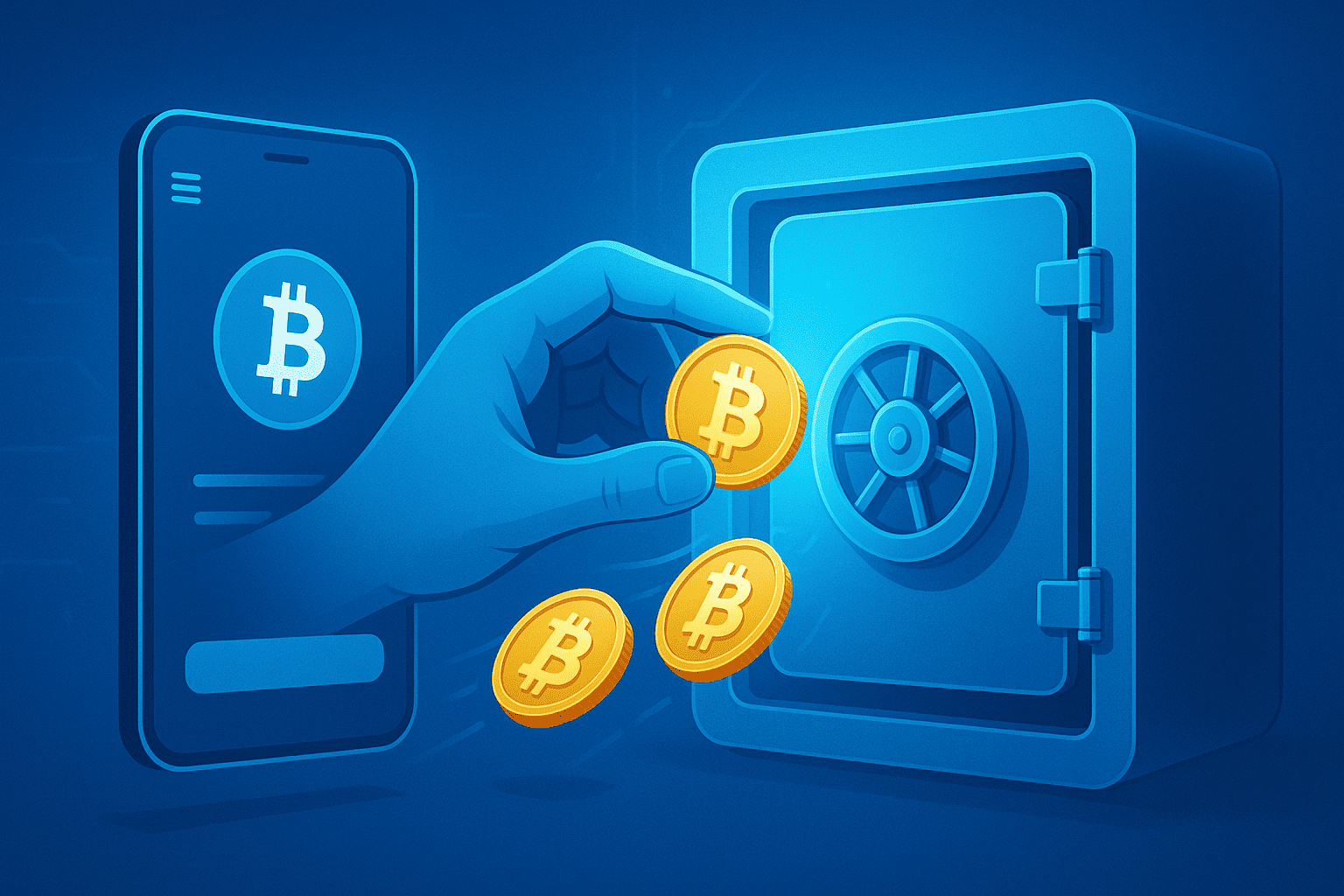
With the rise of crypto trading, knowing how to move your digital assets into real money is essential. The crypto app withdrawal process can seem tricky at first, especially for beginners navigating apps like Coinbase, Binance, or newer platforms such as BitGlide. If you’re new to digital finance, start by understanding how crypto apps work through our beginner’s guide to using crypto apps in 2025. This article walks you step by step through converting crypto to cash in your bank, while highlighting safety, fees, and real-world examples.
What is Crypto Withdrawal?
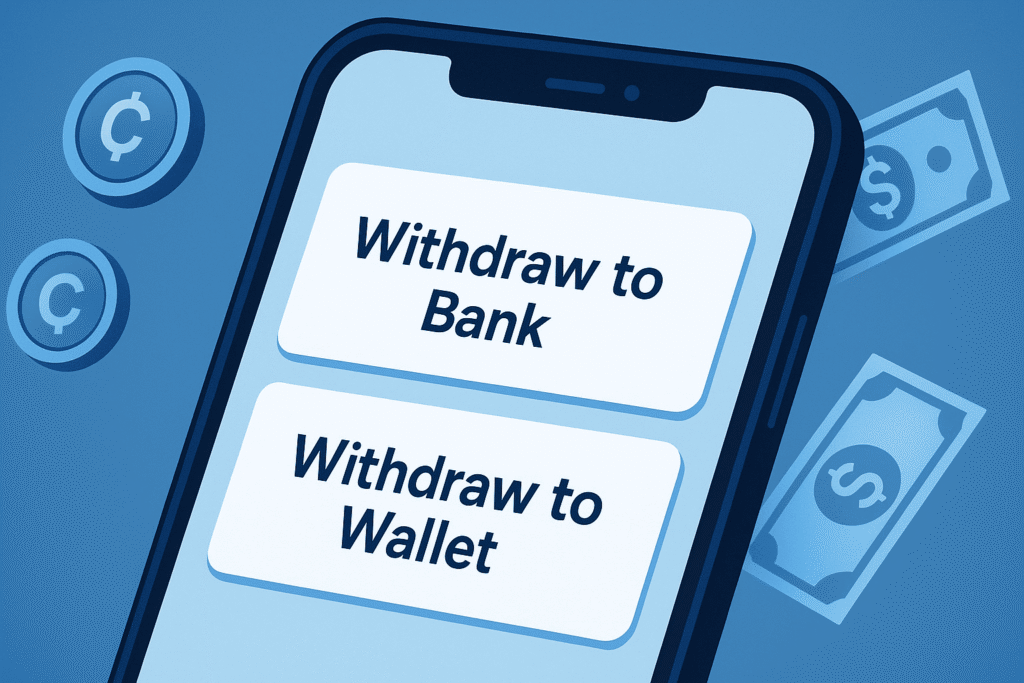
A crypto withdrawal refers to the process of moving funds from a cryptocurrency app or exchange to either a personal wallet or a traditional bank account. Essentially, it’s the step that converts your digital coins into usable cash or transfers them securely for future trading. Withdrawals can be in the form of fiat currencies like USD, EUR, or INR, or in the form of other cryptocurrencies.
The process typically begins with selling your crypto within the app or selecting a withdrawal option. Depending on the platform, funds can reach your bank within minutes or a few business days. For example, Coinbase allows U.S. users to withdraw USD to a linked bank account via ACH, often completing transactions in 1–3 business days, while apps like BitGlide can process instant withdrawals for verified users.
Before withdrawing, you’ll need to store or trade your coins on one of the best crypto investing apps for beginners in 2025. These apps provide the interface to manage balances, track withdrawal fees, and ensure compliance with regulations.
Why Withdraw Funds from Crypto Apps?
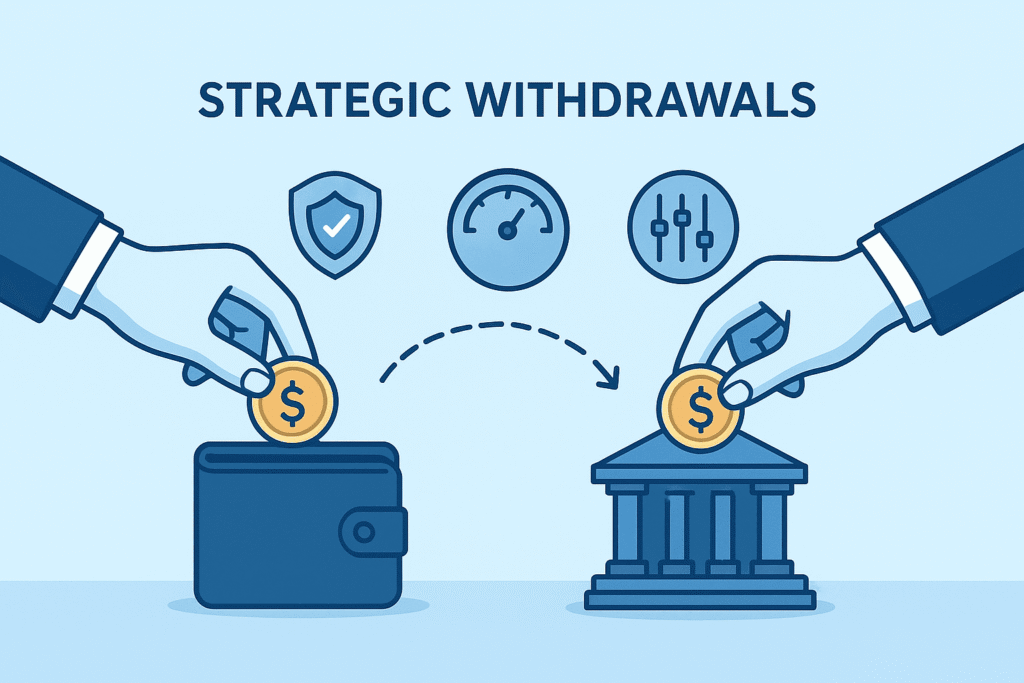
Withdrawing funds from crypto apps isn’t just a matter of convenience—it’s often strategic. Here are the main reasons traders and crypto enthusiasts move their assets into traditional accounts.
To Convert Crypto into Real Money
The primary reason is to convert digital currency into fiat cash. Whether you’ve earned profits from trading ETH or received payments in BTC, withdrawing allows you to pay bills, make purchases, or deposit funds for other investments. Active traders often move funds to their bank after small profits—especially those using platforms like eToro for daily trading.
To Keep Your Money Safe
While exchanges are generally secure, storing large amounts of crypto on a platform carries inherent risk. By withdrawing to a personal wallet or bank, you minimize exposure to exchange hacks, technical glitches, or potential regulatory freezes.
To Use or Spend Your Crypto
Some apps now allow direct crypto spending, but traditional banks remain the easiest way to access your funds. Converting crypto to cash makes everyday transactions simpler—like paying rent or buying groceries—without relying on merchants that accept crypto directly.
To Avoid Platform Fees or Limits
High trading volumes can trigger fees or withdrawal limits. Moving funds to your bank account can reduce long-term costs, especially if your chosen exchange imposes limits on crypto transfers or high network fees.
To Keep Better Control of Your Assets
Finally, withdrawing funds allows users to maintain full control over timing, amounts, and destination accounts. For instance, some traders split withdrawals across multiple banks to diversify risk or optimize timing for lower fees.
By understanding why withdrawals are important, you can better plan your crypto-to-bank transfer in 2025 and avoid unnecessary fees or delays.
Supported Crypto Apps and Banks
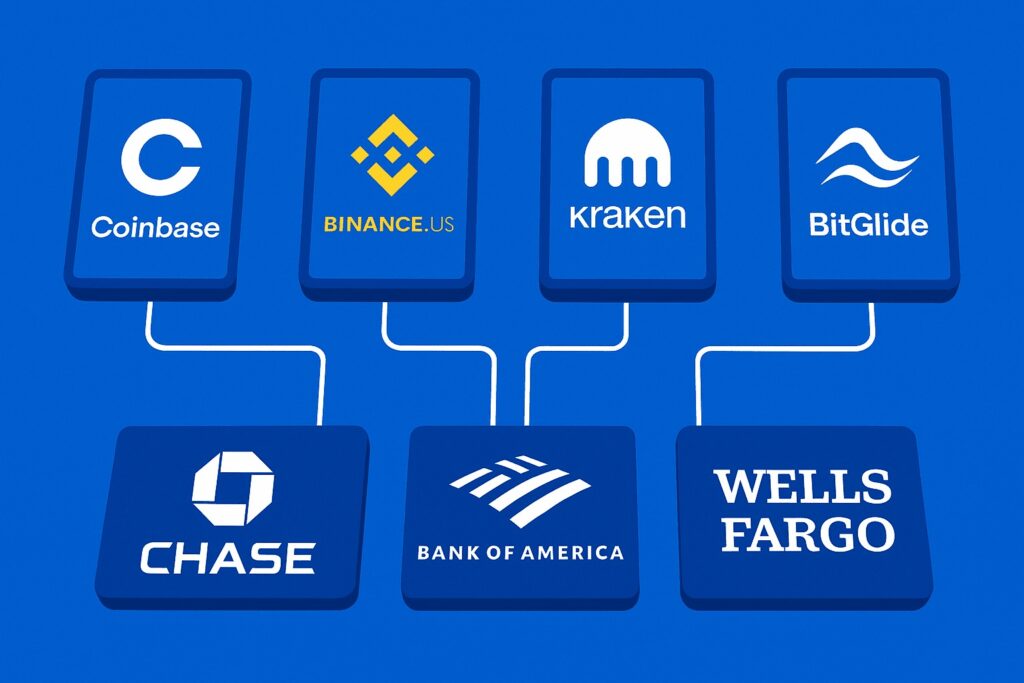
When it comes to withdrawing funds, not all crypto apps are created equal. Some provide instant bank transfers, while others may take a few days depending on verification and network conditions.
Popular crypto apps in the U.S. with reliable withdrawal options include:
- Coinbase: Supports ACH transfers to U.S. banks and instant debit card withdrawals. Users typically report completion times between a few minutes to 3 business days.
- Binance.US: Allows USD withdrawals via bank wire or ACH. Some users have reported faster payouts for verified accounts.
- Kraken: Offers standard bank transfers and supports multiple fiat currencies. Withdrawal fees are usually minimal, around $5 per transaction.
- BitGlide: A newer platform known for fast withdrawals and low fees. Verified users can enjoy near-instant transfers to major U.S. banks.
For beginners, check out Best Crypto Apps in the USA for Beginners (2025) to see which platforms support smooth withdrawals.
Emerging crypto apps focusing on faster transactions include BitGlide and other U.S.-friendly fintech solutions. You can read the BitGlide Review 2025 for real examples of crypto withdrawal success.
Bank support: Most U.S. banks, including Chase, Bank of America, Wells Fargo, and Citi, allow direct transfers from crypto apps via ACH or wire. Smaller regional banks may have longer processing times, so it’s wise to confirm with your bank before initiating withdrawals.
When choosing an app, verify:
- Bank compatibility – Ensure your bank account is eligible for ACH or wire transfers.
- Withdrawal limits – Apps like Coinbase and Binance.US have tiered limits based on verification levels.
- Processing speed – Some apps process withdrawals instantly, while others batch transactions in 24–48 hours.
By understanding which apps and banks are supported, you can streamline your crypto-to-bank transfer and avoid unnecessary delays or fees.
In addition to the major apps mentioned earlier, many crypto platforms have enhanced their crypto app withdrawal process in 2025, offering faster, cheaper, and safer transfers to bank accounts. Understanding each platform’s features, fees, and supported banks can save time and reduce risks.
Coinbase Withdrawal Details
Coinbase is widely recognized for its user-friendly interface, making it ideal for beginners. U.S. users can link their bank accounts via ACH for free withdrawals. For faster access, debit card withdrawals are supported, but fees may apply: typically 1.5% per transaction.
Example:
Jane, a crypto trader in New York, withdrew $2,000 from Coinbase to her Chase account. The ACH transfer took 2 business days, and she paid no network fees because she stayed within the free withdrawal limit.
Binance.US Withdrawal Details
Binance.US supports both ACH and wire transfers. ACH withdrawals are usually free, but wire transfers have a $15 fee. Cryptocurrency can also be sold for USD within the app, and the balance transferred to a linked bank account.
Example:
Tom, an ETH trader, converted 1.5 ETH to USD in Binance.US and transferred it to his Wells Fargo account. ACH transfer completed in 1 business day, while wire transfers would have cost him an extra $15.
Kraken Withdrawal Details
Kraken is known for security and supports multiple fiat currencies. Bank withdrawals are usually completed via ACH in 1–3 business days, or SWIFT for international transfers (with additional fees).
Example:
Samantha, a long-term Bitcoin holder, withdrew $5,000 to her Bank of America account via ACH. Verification took 24 hours, and the transfer was completed the next business day.
BitGlide Withdrawal Details
BitGlide is emerging as a strong alternative for users seeking instant withdrawals. Verified accounts can transfer funds to most U.S. banks within minutes, making it ideal for traders needing quick liquidity.
Example:
A crypto freelancer in California withdrew $500 earned in BTC to his Chase account via BitGlide. The transfer was instant, and the platform charged a minimal 0.5% fee.
Supporting Multiple Bank Accounts
Some platforms, like Coinbase and Binance.US, allow linking multiple bank accounts. This feature is useful for diversifying withdrawals or managing funds across personal and business accounts.
International Users
While U.S. apps dominate, many platforms like Binance Global and Kraken support international bank transfers. SWIFT transfers are standard, though fees are higher ($20–$50 per transaction) and completion times are longer (3–5 business days).
Crypto Wallets vs Bank Accounts
Not all withdrawals need to go to a bank. For frequent traders or long-term holders, sending crypto to a secure wallet like Ledger or Trezor can be safer. However, converting to fiat and moving to a bank is necessary for everyday spending.
Example:
John moved 2 BTC from Coinbase to his Ledger wallet for safekeeping, then withdrew only small amounts to his bank to pay monthly expenses.
Fees and Limits Recap
- Coinbase: Free ACH, $1.49 debit card fee; $100–$25,000 daily limit for verified accounts.
- Binance.US: Free ACH, $15 wire; $10–$50,000 daily limit.
- Kraken: $5–$50 depending on method; daily limits vary by verification level.
- BitGlide: 0.5% fee; instant withdrawals; $5,000 daily limit.
By comparing platforms, users can pick the most suitable app for their withdrawal frequency, speed, and fee sensitivity.
Step-by-Step Guide: How to Withdraw Money
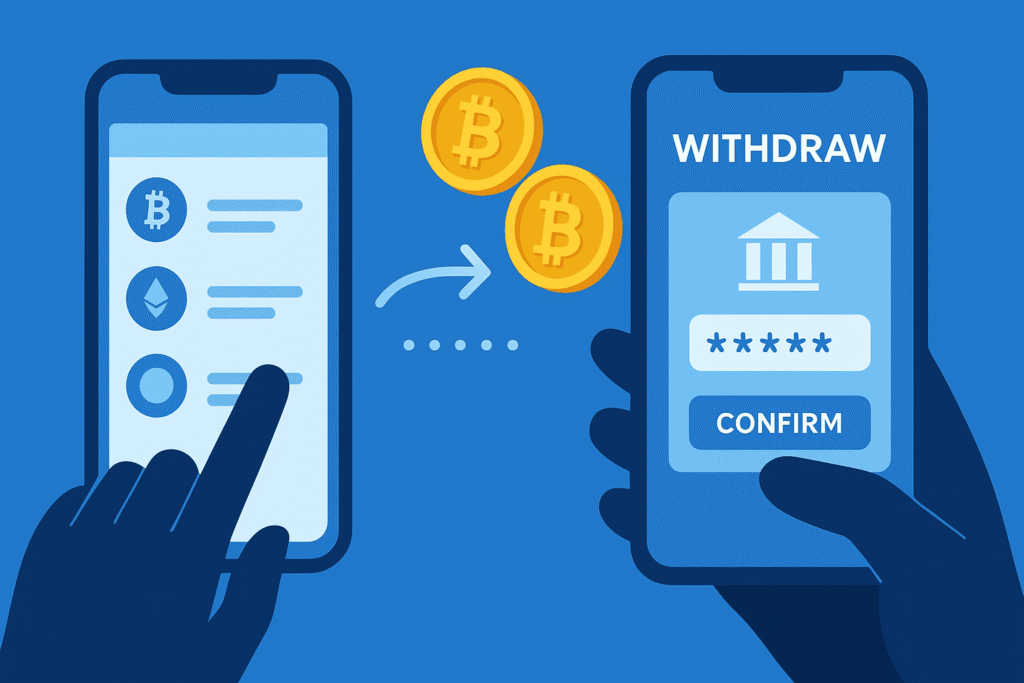
Now that you know which apps and banks are supported, here’s a practical, step-by-step guide to move your crypto into your bank account.
Step 1: Log in to Your Crypto App
Open your app and verify that your account is fully authenticated. Some apps require 2FA (two-factor authentication) before any withdrawal.
Tip: Make sure your app is updated to the latest version to avoid technical glitches.
Example: On Coinbase, users must enter their 2FA code before accessing the “Withdraw” option.
Step 2: Choose “Wallet” or “Account”
Navigate to your app’s wallet or account section, where all your balances are displayed. This is the starting point for withdrawals.
For beginners, see our Top Crypto Trading Apps Guide 2025 (Key Features).
Step 3: Pick What You Want to Withdraw
Select the cryptocurrency you want to convert to cash. Some apps allow you to withdraw a portion or the entire balance.
Example: If you hold 2 ETH, you can choose to withdraw 1 ETH as USD to your bank while leaving the rest in the app.
Step 4: If Withdrawing to a Bank (Cash Out)
- Select “Withdraw to Bank” or “Cash Out.”
- Choose your linked bank account.
- Enter the amount to withdraw.
- Confirm details and fees.
Example: On BitGlide, users can withdraw $500 to their Chase account with a single click, completed instantly.
Step 5: If Withdrawing to a Crypto Wallet
- Select “Withdraw to Wallet.”
- Enter the wallet address carefully.
- Choose the network (e.g., Ethereum, Bitcoin).
- Confirm transaction.
Step 6: Check Your Transaction
Double-check all details: wallet address, bank account, and amount. Errors can lead to permanent loss.
Example: Sending BTC to the wrong network can delay or lose funds; always verify addresses.
Step 7: Wait for Completion
ACH transfers usually take 1–3 business days, while debit card withdrawals or instant apps like BitGlide may complete in minutes.
Pro Tip: Track your transaction via the app or bank portal to confirm receipt.
If you face delays, check Honest Reviews of the Most Popular Crypto Trading Apps (2025) for troubleshooting tips.
Withdrawal Limits and Timing
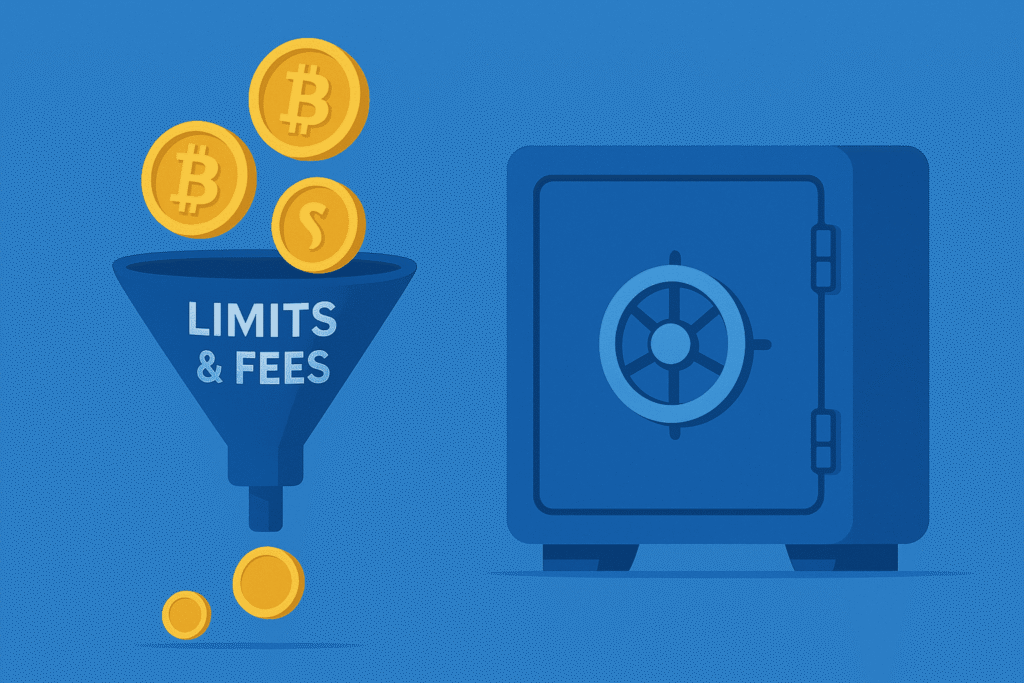
Withdrawal limits depend on app verification, account type, and method chosen.
- Coinbase: Verified U.S. users can withdraw $100–$25,000 per day. ACH transfers usually take 1–3 business days.
- Binance.US: Daily limit ranges $10–$50,000; ACH transfers are free, wire transfers faster but cost $15.
- Kraken: Limits vary by verification level; ACH transfers take 1–3 business days, SWIFT 3–5 days.
- BitGlide: Daily limit of $5,000; instant withdrawals for verified users.
Timing Tips:
- ACH transfers: Best for routine withdrawals; safe and reliable but slower.
- Debit card or instant withdrawals: Faster but may have higher fees.
- International transfers: Allow 3–5 business days for SWIFT transactions.
Example:
Lisa withdrew $3,000 from Coinbase to her Bank of America account. ACH transfer took 2 days. Had she used a debit card, it would have been instant with a 1.49% fee.
Being aware of limits and timing allows users to plan withdrawals strategically, avoiding delays or rejection due to exceeding daily thresholds.
Common Issues and How to Solve Them
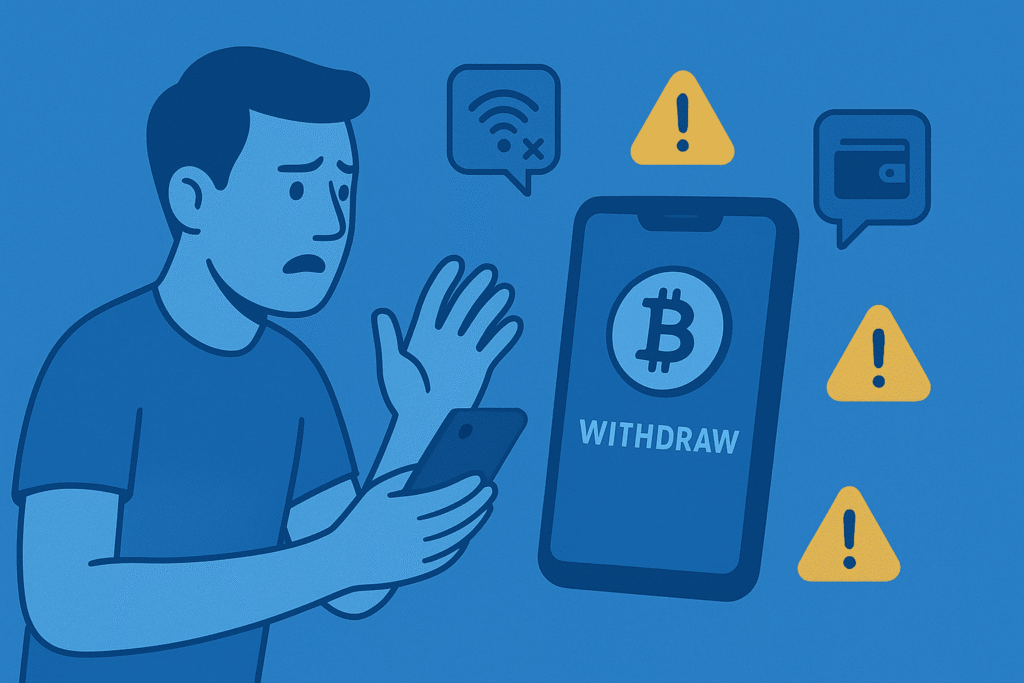
Even with smooth platforms, withdrawals can face hurdles. Here’s a practical guide.
Slow or Stuck Withdrawals
Cause: Network congestion or platform delays.
Solution: Check transaction ID and network status; contact support if delayed beyond 48 hours.
Wrong Wallet Address
Cause: Typo or wrong network selected.
Solution: Always double-check addresses; small test transfers help.
Name or Account Mismatch
Cause: Bank account details not matching your crypto app profile.
Solution: Update account information to match KYC records.
Withdrawal Limits or Minimums
Cause: Daily limits or minimum withdrawal requirements.
Solution: Split withdrawals or wait until limits reset.
Security Holds or Verification Checks
Cause: Suspicious activity or large transfers.
Solution: Complete all verification steps; ensure 2FA is active.
Insufficient Balance or Fees
Cause: Not accounting for network or platform fees.
Solution: Check total amount including fees before withdrawing.
App or Network Maintenance
Cause: Scheduled downtime or blockchain updates.
Solution: Monitor official announcements; avoid withdrawing during maintenance.
For app-specific issues, see Honest Reviews of the Most Popular Crypto Trading Apps (2025).
Following these solutions ensures a smoother crypto app withdrawal process, avoiding common pitfalls.
Tips for Safe and Efficient Withdrawals
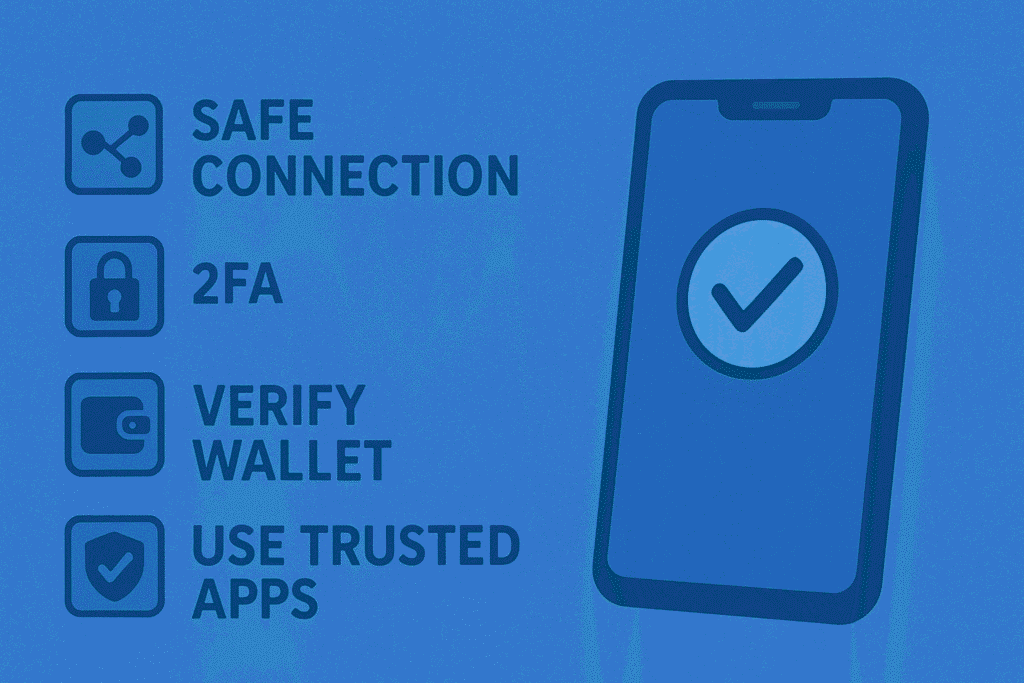
Ensuring withdrawals are safe and cost-effective requires simple best practices:
Use a Safe Connection
Avoid public Wi-Fi when accessing your crypto app. Use trusted networks or a VPN.
Turn On Extra Security
Enable 2FA and withdrawal whitelist features.
Check the Wallet Address Carefully
Copy-paste addresses carefully and verify network compatibility.
Pick the Right Time to Withdraw
Avoid peak network congestion to reduce gas fees.
Use Trusted Apps and Wallets
Stick to established apps like Coinbase, Binance.US, or BitGlide for secure transfers.
Keep Your Account Verified
Verified accounts unlock higher limits and faster withdrawals.
Review Fees and Limits
Compare ACH, wire, and debit card options to optimize costs.
Stay Alert and Monitor Activity
Regularly check app notifications and bank statements for unusual activity.
Choose the Right Network
Selecting a low-fee network like Solana or Polygon for transfers can save money compared to Ethereum mainnet.
Example:
Alex transferred $500 using Ethereum during peak hours and paid $12 in gas. Using Polygon network instead would have cost less than $1.
By following these tips, users can execute crypto to bank transfers 2025 efficiently, minimizing fees and risks while maximizing convenience.
Benefits of Direct Bank Withdrawals
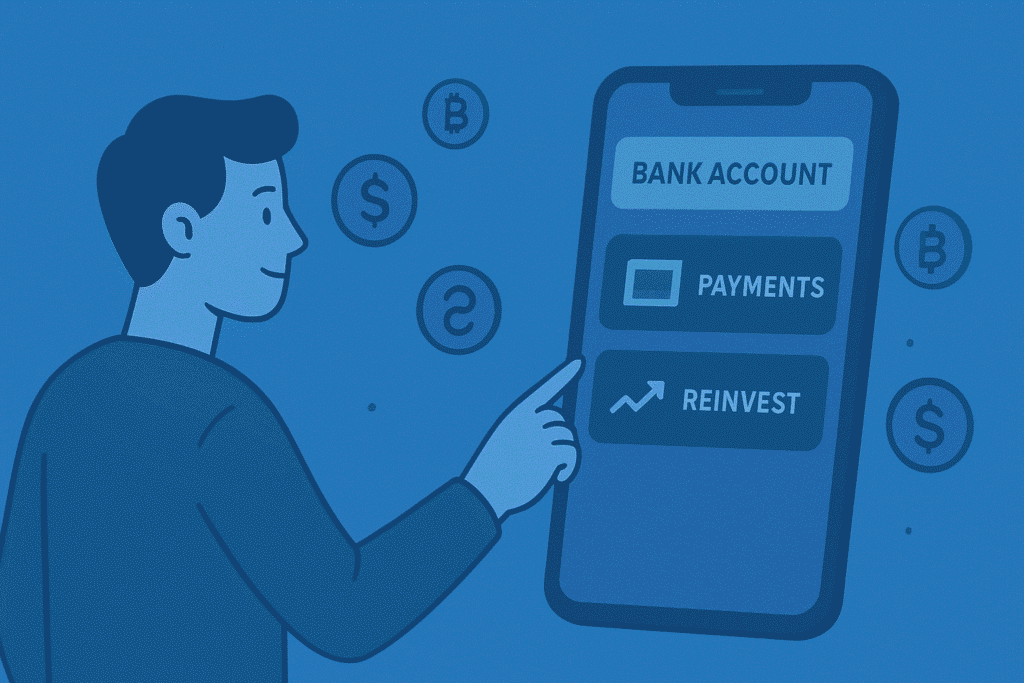
Direct withdrawals to your bank are often the simplest and safest way to access your crypto profits. Here’s why:
Fast and Convenient
Linking a bank account allows users to convert crypto to cash and have it deposited directly, often within 1–3 business days. Instant apps like BitGlide even complete withdrawals in minutes.
Simple and Easy to Use
Bank withdrawals eliminate the need for manual wallet transfers or dealing with complex blockchain addresses. Most apps have a “Cash Out to Bank” button, streamlining the process.
Lower Fees
ACH transfers are usually free, unlike wire transfers or high gas fee blockchain transactions. Over time, this reduces costs significantly, especially for frequent withdrawals.
Safer and More Secure
Banks provide regulatory oversight and fraud protection. Unlike crypto wallets, you’re covered if suspicious activity occurs, and your funds are insured in many cases.
Good for Managing Your Money
With money in your bank, you can budget, pay bills, or reinvest in other opportunities easily.
Compliant with Regulations
Direct bank withdrawals ensure proper documentation, making it easier to comply with tax reporting requirements.
Example:
Rachel withdrew $1,500 from Coinbase to her Bank of America account. ACH transfer was free, completed in 2 business days, and she could immediately use the funds to pay monthly expenses.
Alternatives to Bank Withdrawals
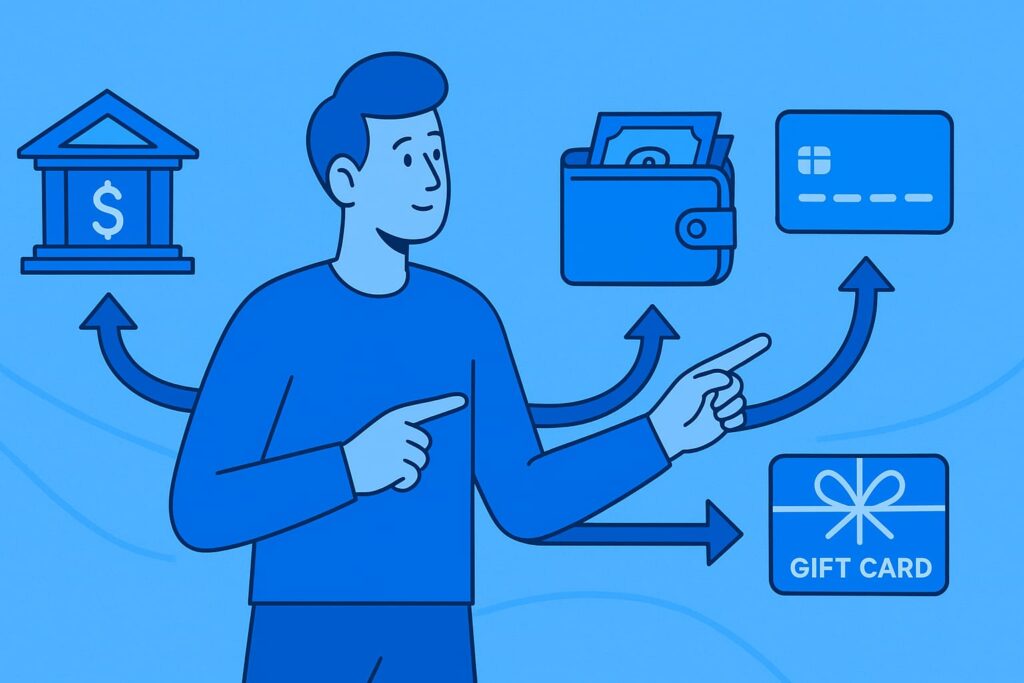
While bank transfers are standard, there are other ways to access crypto profits:
Use a Crypto Debit Card
Platforms like Coinbase and Binance offer debit cards that let you spend crypto directly. Purchases are converted automatically to fiat at the point of sale.
Withdraw Using PayPal or e-Wallets
Some apps allow transferring funds to PayPal, Venmo, or other e-wallets for faster access.
Use a Bitcoin ATM
BTC can be sold at Bitcoin ATMs to receive cash instantly, though fees can be high (5–10%).
Sell Through Peer-to-Peer (P2P) Platforms
Platforms like LocalBitcoins allow you to sell directly to other users for cash or bank transfer. Ensure you use verified buyers.
Convert to Gift Cards
Some services allow converting crypto into gift cards for Amazon, Walmart, or Visa, which can be convenient for spending without withdrawing cash.
Transfer to Another Wallet or Exchange
Traders may move funds to other exchanges for better rates or withdrawal options, including apps with lower fees or faster processing.
Example:
Mike used a Binance crypto debit card to pay for groceries, converting $50 worth of BTC without a bank transfer.
Alternatives are useful for those who want flexibility or faster access without waiting for ACH or wire transfers.
Tax Implications of Crypto Withdrawals
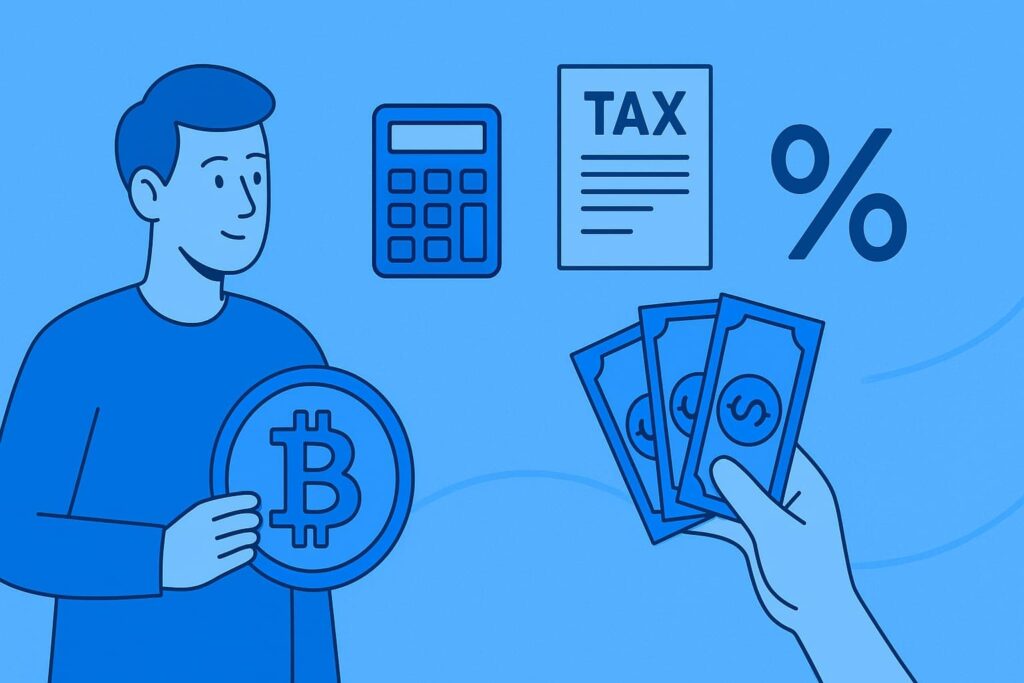
Understanding taxes is crucial when converting crypto to fiat. While withdrawing crypto itself is not taxed, the actions surrounding it can trigger taxable events.
Holding Crypto Isn’t Taxed
Simply keeping crypto in an app or wallet does not create a taxable event.
Selling Crypto for Cash
Selling BTC, ETH, or other cryptocurrencies for USD is considered a taxable event. Profits are subject to capital gains tax.
Example:
Anna bought 1 ETH for $2,000 and sold it for $2,500 before withdrawing. She owes taxes on the $500 gain.
Trading One Crypto for Another
Swapping ETH for BTC is also taxable. The IRS treats it as selling the first asset at market value, even if no cash is involved.
Using Crypto to Buy Something
Purchasing goods or services with crypto triggers taxable gains based on market value at the time of the transaction.
Earning Crypto Income
Mining, staking rewards, or airdrops are considered income and taxed at ordinary rates when received.
Short-Term vs Long-Term Tax Rates
Assets held for less than a year are taxed at short-term rates, while those held longer may qualify for lower long-term capital gains rates.
No Tax Just for Withdrawing
Linking your bank account and moving USD from your app is not a taxable event by itself. Taxes apply only to conversions or gains.
Example:
David withdrew $1,000 USD from Coinbase that he already converted from BTC. The withdrawal itself isn’t taxed, but he reports the $1,000 gain on his tax return if it exceeds cost basis.
Understanding these rules helps users avoid surprises during crypto to bank transfers in 2025.
Best Practices for Choosing the Right Withdrawal Method
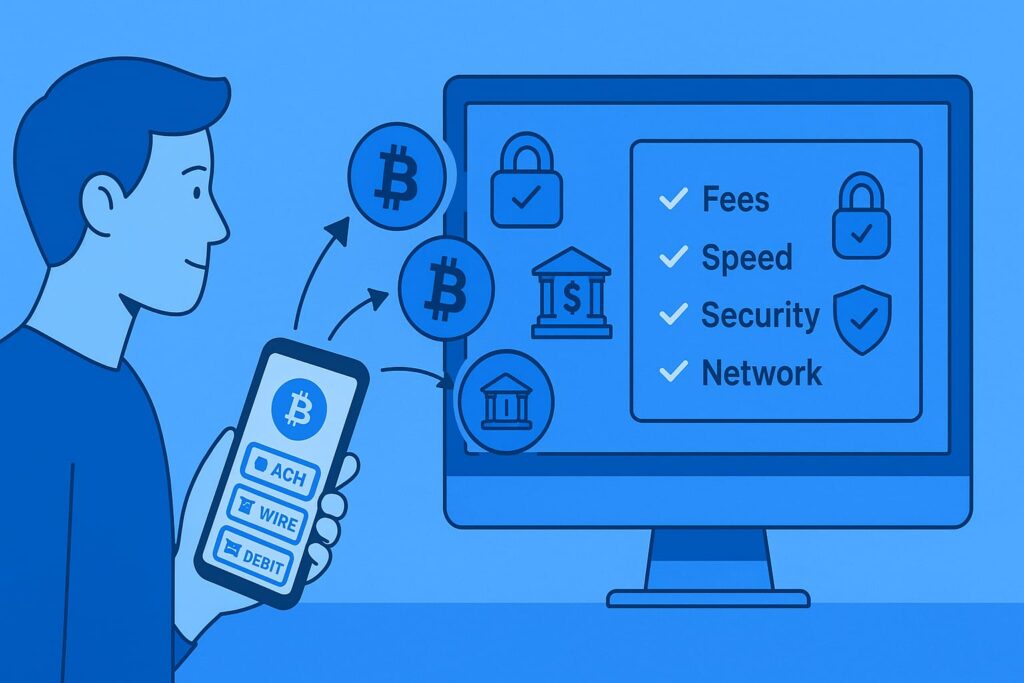
Selecting the right withdrawal method balances speed, fees, and security.
Understand Withdrawal Options
Know if your app supports ACH, wire, debit card, or wallet withdrawals. Each has pros and cons in terms of speed and fees.
Compare Fees and Speeds
Some apps charge more for instant withdrawals. Compare options to ensure you get the best value.
Prioritize Safety
Use verified apps with strong security. Avoid unknown platforms or public Wi-Fi when transferring funds.
Choose the Right Network
When sending crypto to a wallet, low-fee networks like Polygon or Solana reduce costs, while Ethereum may be expensive during high network traffic.
Check Limits and Requirements
Ensure your withdrawal doesn’t exceed daily limits or violate minimum withdrawal rules. Splitting large amounts may be necessary.
Double-Check All Details
Verify bank account numbers, wallet addresses, and network selections. One small mistake can result in permanent loss.
Monitor and Track Withdrawals
Use your app or bank portal to track progress. Confirm receipt before marking the transaction complete.
Example:
Sophie withdrew $2,500 from Binance.US to her Chase account. She split the amount into two transactions of $1,250 to stay under daily limits and avoided fees.
Following these best practices ensures that your crypto to bank transfer 2025 is secure, cost-effective, and stress-free.
Mobile vs Desktop Crypto Withdrawals
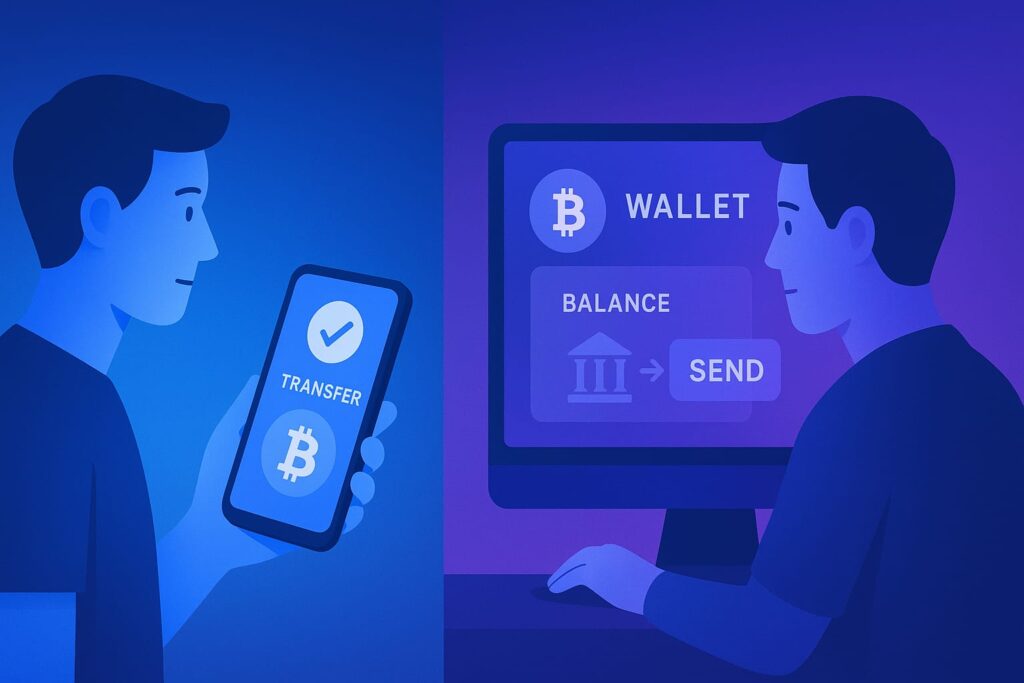
Choosing between mobile and desktop platforms affects convenience, speed, and security.
Convenience
Mobile apps allow you to withdraw anywhere, anytime. Apps like Coinbase and BitGlide have streamlined interfaces for on-the-go withdrawals. Desktop platforms provide a larger screen for tracking multiple wallets and monitoring transactions.
Example:
Emma withdrew $500 from her BitGlide mobile app while commuting. She preferred the desktop interface when managing multiple accounts at home.
Security
Desktop withdrawals are generally safer because devices can run antivirus and firewall protections. Mobile apps rely on device security, so enabling 2FA and keeping apps updated is essential.
Speed
Mobile apps often offer instant notifications and easier verification via biometrics, speeding up withdrawals. Desktop withdrawals may take longer for verification but provide a better overview of fees and network choices.
Risks
Mobile devices can be lost or hacked, while desktops are less portable and more prone to phishing attacks. Combining both—using mobile for quick transfers and desktop for large or complex withdrawals—is a smart approach.
Case Study: Withdrawal Examples from Popular Apps
Coinbase:
John sold 1 ETH for $2,500 and withdrew via ACH to Bank of America. The transfer took 2 business days and no extra network fees applied.
Binance.US:
Lisa converted 0.5 BTC to USD and used a wire transfer to her Wells Fargo account. The process completed in 24 hours with a $15 fee.
BitGlide:
A freelancer withdrew $1,000 earned in BTC to Chase. Verified account allowed instant transfer, costing only $5 in fees.
Kraken:
Samantha moved $5,000 USD from her Kraken account to a US bank via ACH. The transfer took 2 business days.
These examples show the importance of choosing the right platform based on speed, fees, and verification levels.
How Exchange Regulations Affect Withdrawals
Regulations affect how crypto apps handle withdrawals:
- KYC/AML Requirements: Most U.S. exchanges require identity verification before withdrawals, ensuring compliance with anti-money laundering rules.
- Limits on Large Transfers: Daily or monthly limits prevent fraud and maintain regulatory compliance.
- Reporting Requirements: Exchanges must report large transactions to tax authorities.
Example:
A withdrawal of $50,000 might be flagged for review on Coinbase due to federal reporting regulations, causing a temporary hold.
Being aware of regulations ensures smooth withdrawals without unexpected delays.
Preventing Fraud and Scams
Crypto withdrawals are targets for scams. Protect yourself with these tips:
Check the App and Website
Only use official apps or verified websites to avoid phishing scams.
Protect Your Wallet and Passwords
Never share your private keys or passwords. Use secure, encrypted wallets.
Watch Out for Fake Withdrawal Fees
Scammers may request “extra fees” outside the platform. Always confirm within the app.
Don’t Fall for Promises of Big Profits
Fraudsters lure users with quick gains; withdrawals may be delayed or stolen.
Beware of Unwanted Contacts
Ignore unsolicited calls or messages claiming to help with crypto withdrawals.
Double-Check Withdrawal Details
Verify wallet addresses, network selections, and bank details before confirming transfers.
Future of Crypto Withdrawals
The withdrawal experience is evolving:
Faster and Easier Withdrawals
Apps are implementing instant ACH or debit card withdrawals for U.S. users, reducing delays.
Better Security
Multi-layer authentication, hardware wallet integrations, and AI-driven fraud detection enhance safety.
More Government Rules
Expect clearer reporting and compliance requirements, making withdrawals more transparent.
Taxes and Compliance Tools
New tools integrated into apps will automatically calculate gains and generate tax reports, simplifying end-of-year reporting.
Example:
Coinbase and Kraken already provide automatic tax reports for U.S. users, streamlining withdrawal-related reporting.
Frequently Asked Questions
How long does a crypto app withdrawal take to reach my bank?
ACH transfers: 1–3 business days; wire transfers: 1 day; instant apps: minutes.
Are there fees for withdrawing to a bank account?
ACH is usually free; debit card withdrawals may have 1–1.5%; wire transfers $10–$25.
Can I withdraw all types of cryptocurrencies to my bank?
No. Most apps require converting crypto to USD or other fiat before withdrawal.
Why was my withdrawal declined?
Possible reasons: KYC mismatch, insufficient balance, daily limit exceeded, or security hold.
Is it safe to link my bank account to a crypto app?
Yes, if the app is verified and 2FA is enabled.
What is the minimum withdrawal amount?
Varies by platform: Coinbase $1, Binance.US $10, BitGlide $5.
Can I schedule automatic withdrawals?
Some apps support scheduled transfers for recurring payouts.
Do withdrawals affect my taxes?
No, withdrawals alone aren’t taxed. Selling or converting crypto triggers taxable events.
Conclusion
Withdrawing funds from a crypto app to your bank in 2025 is now safer, faster, and more accessible than ever. Understanding the crypto app withdrawal process, supported apps and banks, fees, and security measures ensures your funds reach you efficiently.
Platforms like Coinbase, Binance.US, Kraken, and BitGlide provide a range of options for ACH, wire, or instant transfers. By following best practices—double-checking addresses, monitoring fees, and staying aware of regulations—you can avoid common pitfalls.
Alternatives like crypto debit cards, P2P platforms, or e-wallet withdrawals offer flexibility, while tax considerations help keep you compliant with the IRS. Mobile and desktop platforms each have benefits, and security should always remain a top priority.
Once your funds reach your bank, you can reinvest using one of the best crypto investing apps in 2025 or explore how staking $1,000 can generate passive income through our detailed guide.
By planning withdrawals carefully, you convert your digital assets into real-world value safely, efficiently, and profitably.
